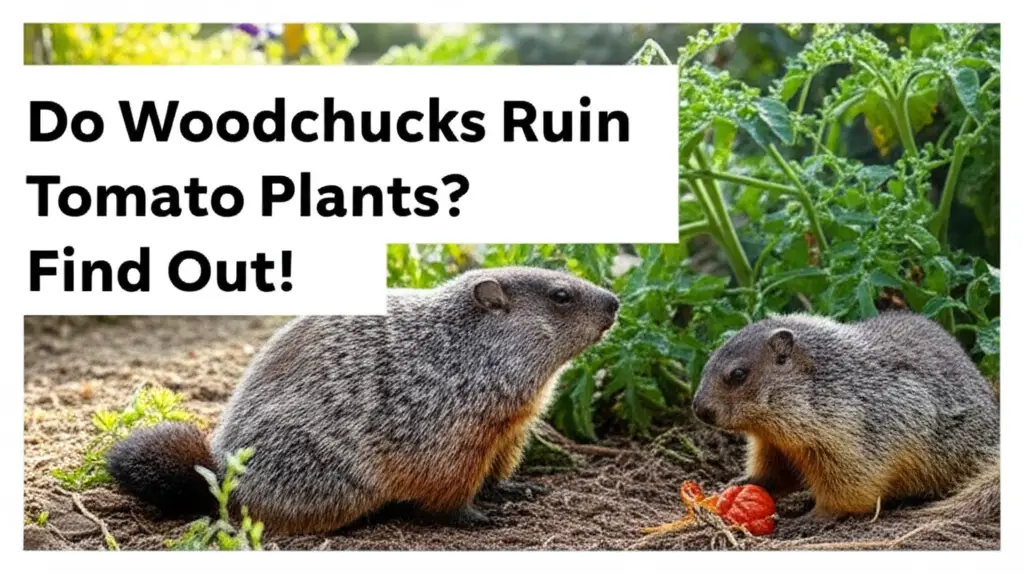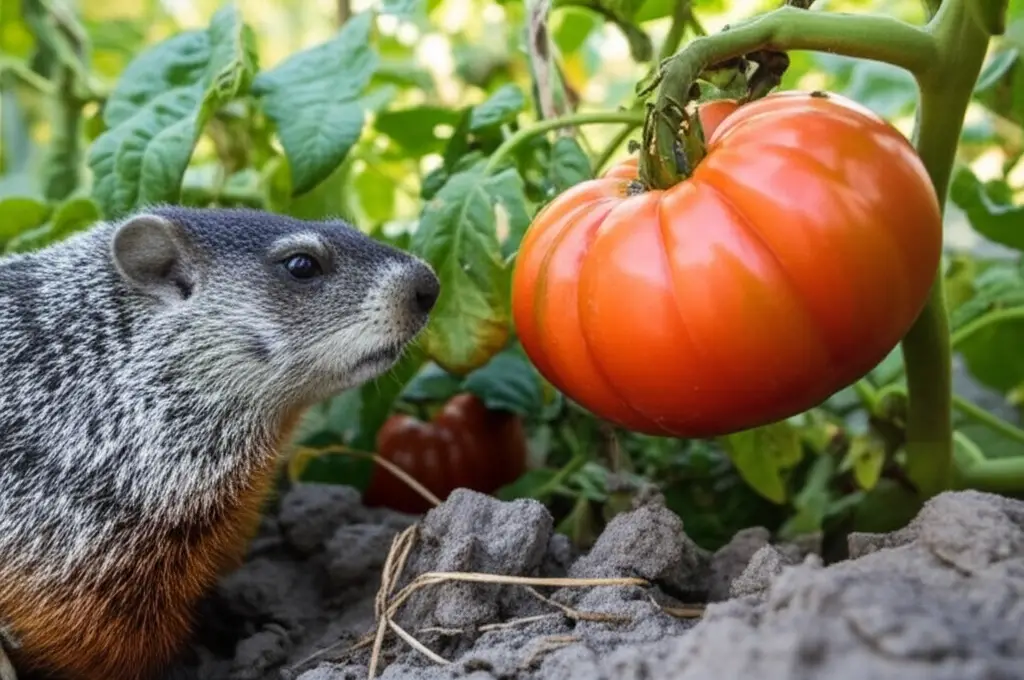This post explores whether woodchucks are a threat to your tomato garden and provides effective strategies to protect your precious plants from these persistent critters.

Woodchucks, also known as groundhogs, are notorious garden raiders. This post delves into their dietary habits, confirms whether tomato plants are on their menu, and provides practical, humane solutions to deter them and safeguard your tomato harvest.
JUMP TO TOPIC
- 1 Understanding the Woodchuck Diet: Are Tomatoes on the Menu?
- 2 Signs of Woodchuck Damage in Your Tomato Garden
- 3 Effective Methods for Protecting Tomato Plants from Woodchucks
- 4 Natural Predators and Deterrents
- 5 Comparing Woodchuck Damage to Other Garden Pests
- 6 Coexisting with Woodchucks: Finding a Balance
- 7 FAQs about Woodchucks and Tomato Plants
- 8 Conclusion
Understanding the Woodchuck Diet: Are Tomatoes on the Menu?
Woodchucks are primarily herbivores, with a diet consisting of various plants, grasses, fruits, and vegetables. They are particularly fond of tender greens and succulent fruits. While they might not exclusively target tomatoes, the sweet, juicy nature of ripe tomatoes makes them an appealing snack for these hungry critters. Understanding their dietary preferences is the first step in protecting your garden. Woodchucks are opportunistic eaters, and if given easy access, they will certainly munch on your tomato plants, impacting your harvest.
Signs of Woodchuck Damage in Your Tomato Garden
Identifying woodchuck damage early is crucial for effective intervention. Look for the following signs:
Clean cuts: Woodchucks have sharp teeth that leave clean, angled cuts on stems and fruits, unlike the ragged tearing caused by other pests.
Missing fruits: If ripe tomatoes disappear without a trace, woodchucks might be the culprits. They often carry their food back to their burrows.
Tracks and droppings: Large, five-toed footprints and sizeable, dark droppings near your garden are telltale signs of woodchuck activity.
Burrows: Look for groundhog burrows near your garden. These are typically large holes with mounds of excavated dirt.
Effective Methods for Protecting Tomato Plants from Woodchucks
Protecting your tomato plants from woodchucks requires a multi-pronged approach. Here are some proven methods:
Fencing: A sturdy fence is the most effective deterrent. Use wire mesh fencing at least 3 feet high and bury it 1 foot deep to prevent them from digging underneath. Extend the fence outwards at a 90-degree angle underground for even more protection.
Repellents: Commercial woodchuck repellents can deter these animals. Choose environmentally friendly options and follow the instructions carefully. Homemade repellents using strong-smelling ingredients like garlic, pepper, or ammonia can also be effective, although they may need to be reapplied frequently, especially after rain.
Trapping: Live trapping can be a humane way to remove woodchucks from your property. Consult local wildlife authorities for regulations and recommendations before trapping and relocating any animals.
Eliminating Attractants: Keep your garden clean and free of debris that could provide cover for woodchucks. Remove weeds and fallen fruit promptly.
Natural Predators and Deterrents
Encouraging natural predators can help control woodchuck populations. Foxes, coyotes, and large birds of prey are natural enemies of woodchucks. Providing suitable habitat for these predators, such as brush piles or tall grasses, can increase their presence in your area.
You can also consider using deterrents like:
Motion-activated sprinklers: These can startle woodchucks and deter them from entering your garden.
Ultrasonic devices: Emitting high-frequency sounds, these devices can be effective but their effectiveness can vary.
Guard dogs: A well-trained dog can be a powerful deterrent to woodchucks and other garden pests.
Comparing Woodchuck Damage to Other Garden Pests
While woodchucks can cause significant damage, it’s important to differentiate their impact from other common garden pests. Rabbits, for instance, tend to nibble on leaves closer to the ground, whereas woodchucks can reach higher and damage more of the plant. Squirrels might target fruits but tend to leave jagged edges, unlike the clean cuts made by woodchucks. Recognizing the specific type of damage helps in implementing the most appropriate control measures.
Coexisting with Woodchucks: Finding a Balance
While protecting your garden is essential, it’s also important to remember that woodchucks play a role in the ecosystem. They are a food source for larger predators and their burrows can provide shelter for other animals. Consider using non-lethal methods whenever possible and focus on deterring them from your garden rather than eradication. Creating a dedicated “woodchuck area” away from your garden with preferred food sources can sometimes divert their attention from your valuable plants.
FAQs about Woodchucks and Tomato Plants
Q: Are woodchucks active during the day or night?
A: Woodchucks are primarily diurnal, meaning they are most active during the daytime, especially early morning and late afternoon.
Q: What time of year are woodchucks most active in gardens?
A: Woodchucks are typically most active in gardens during spring and summer when food is abundant. They enter hibernation in the fall.
Q: Can I use mothballs to repel woodchucks?
A: Mothballs are not recommended as they can be toxic to pets, children, and other wildlife.
Q: What should I do if I find a baby woodchuck?
A: If you find a baby woodchuck, it’s best to contact a local wildlife rehabilitator. They have the expertise to care for orphaned or injured wildlife.
Conclusion
Protecting your tomato plants from woodchucks requires vigilance and a combination of strategies. Understanding their behavior, implementing effective deterrents, and adopting preventative measures can help you enjoy a bountiful tomato harvest while respecting the role these creatures play in the ecosystem. By choosing humane and environmentally friendly solutions, we can coexist peacefully with these persistent garden visitors.

